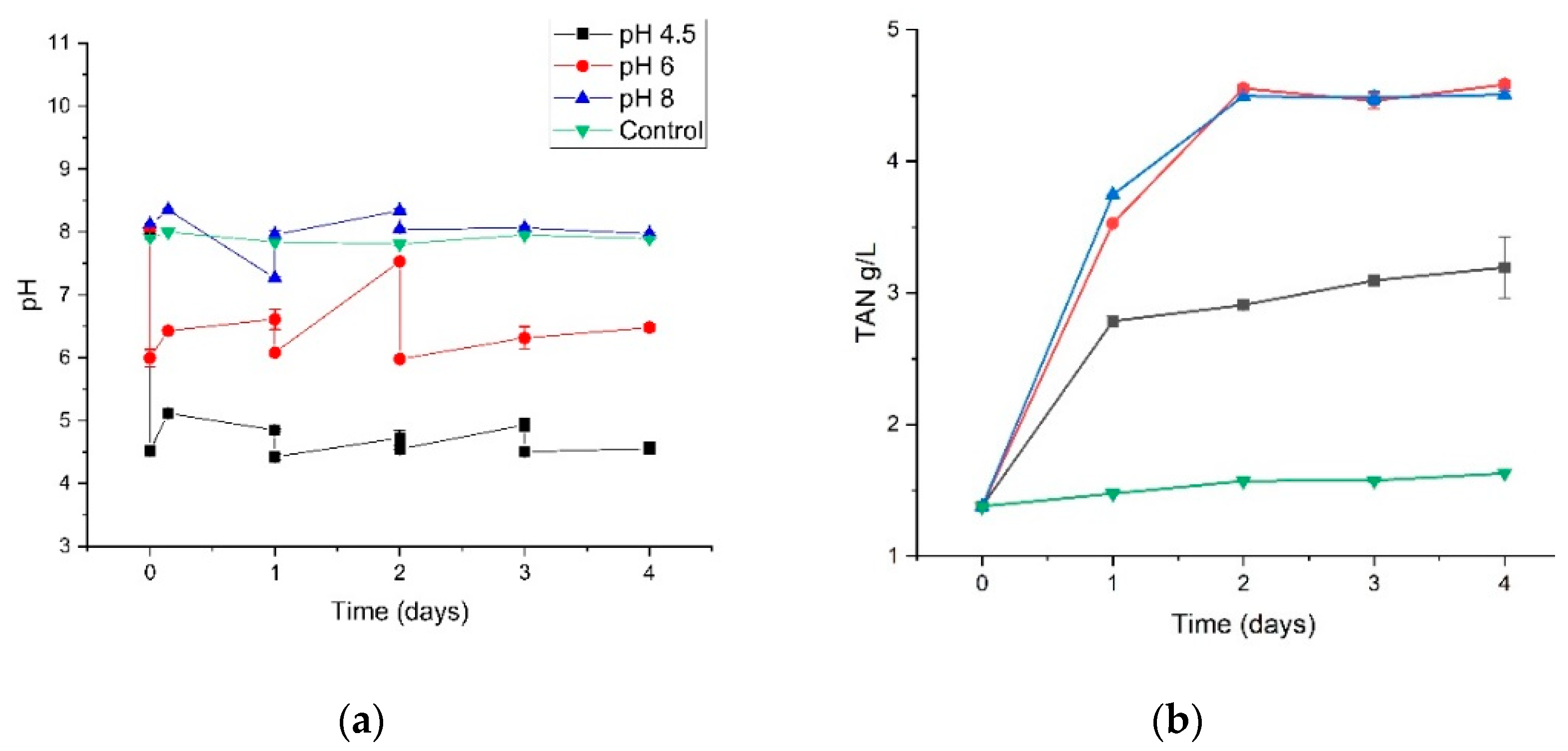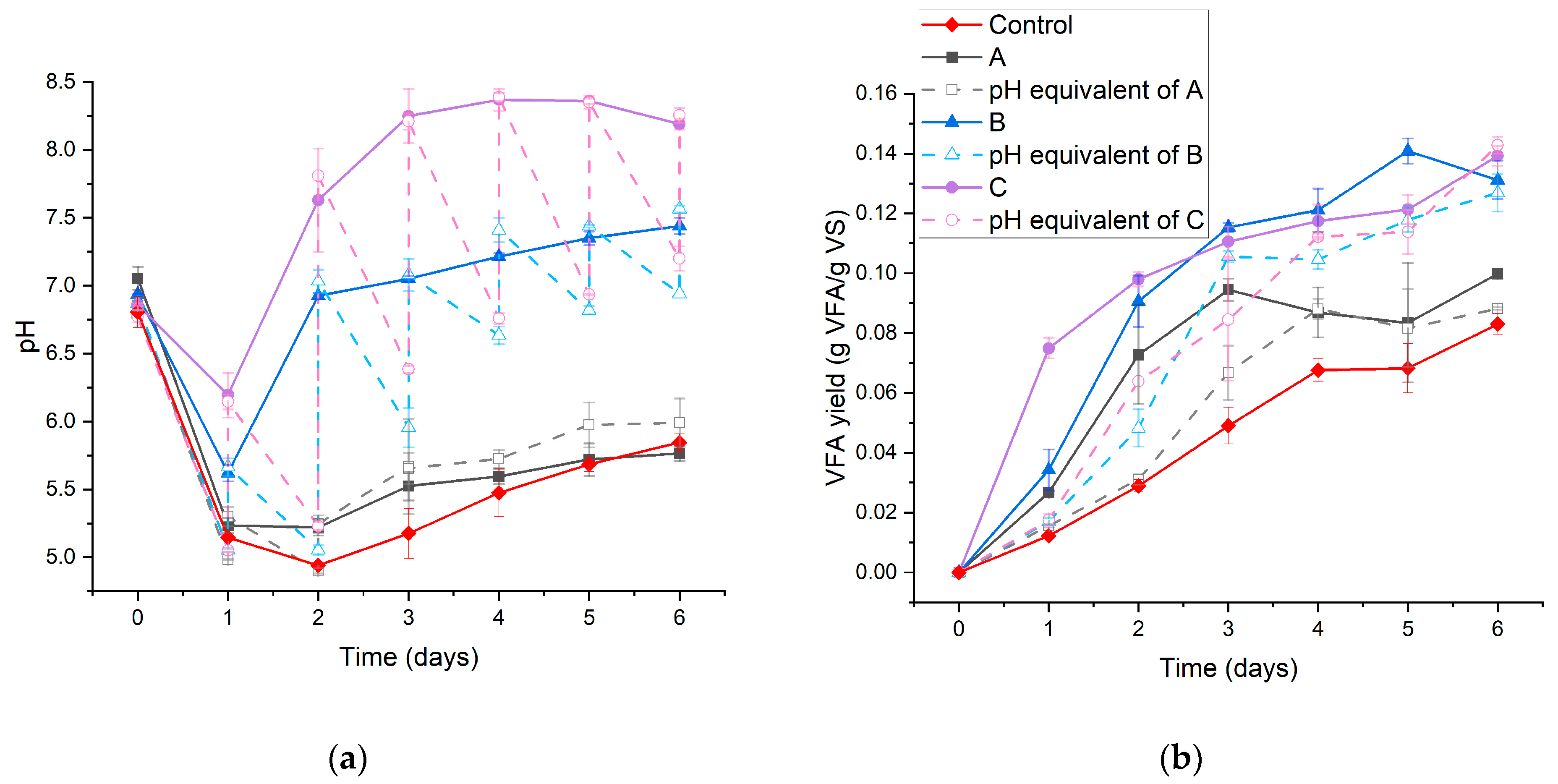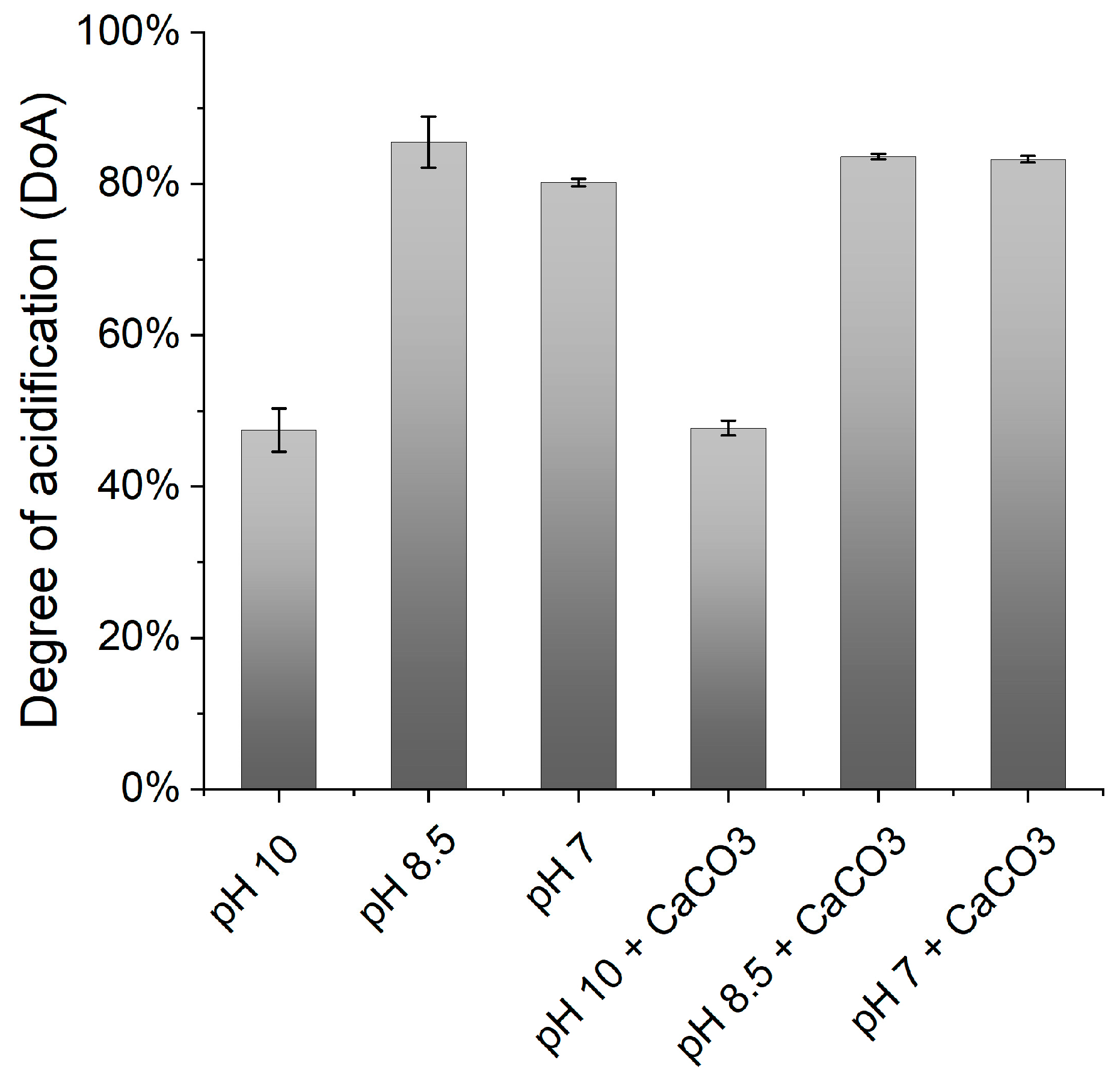Acidogenic Fermentation of Organic Residual Solids: Effect of Different Alkaline Sources on pH, Alkalinity, and Fermentation Performance
Abstract
:1. Introduction
2. Materials and Methods
2.1. Materials
2.2. Compositional Analysis
2.3. Experiments
2.3.1. Urea Addition Experiment—Part I
2.3.2. Urea Addition Experiment—Parts II and III
2.3.3. CaCO3 Addition Experiment
2.4. Analytical Methods
2.5. Microbial Community Analysis
2.6. Calculations of Yield and Degree of Acidification
3. Results and Discussion
3.1. Results from Compositional Analysis
3.2. Part I—pH Effect on Urea Hydrolysis
3.3. Part II—Urea Addition Effect on AF of Untreated ORS
3.4. Part III—Urea Addition Effect on SHF of ORS
3.5. Part III—Biodiversity and Relative Abundance
3.6. CaCO3 Addition—pH and Alkalinity Effect on SHF of ORS
4. Conclusions
Supplementary Materials
Author Contributions
Funding
Institutional Review Board Statement
Informed Consent Statement
Data Availability Statement
Acknowledgments
Conflicts of Interest
References
- Shen Lee, W.; Seak May Chua, A.; Koon Yeoh, H.; Cheng Ngoh, G. A review of the production and applications of waste-derived volatile fatty acids. Chem. Eng. J. 2014, 235, 83–99. [Google Scholar] [CrossRef]
- Baumann, I.; Westermann, P. Microbial Production of Short Chain Fatty Acids from Lignocellulosic Biomass: Current Processes and Market. BioMed Res. Int. 2016, 2016, 8469357. [Google Scholar] [CrossRef] [PubMed]
- Gerardi, M.H. The Microbiology of Anaerobic Digestion; John Wiley & Sons, Inc.: Hoboken, NJ, USA, 2003. [Google Scholar]
- Arslan, D.; Steinbusch, K.J.J.; Diels, L.; Hamelers, H.V.M.; Strik, D.P.B.T.B.; Buisman, C.J.N.; De Wever, H. Selective short-chain carboxylates production: A review of control mechanisms to direct mixed culture fermentations. Crit. Rev. Environ. Sci. Technol. 2016, 46, 592–634. [Google Scholar] [CrossRef]
- Bhatia, S.K.; Yang, Y.-H. Microbial production of volatile fatty acids: Current status and future perspectives. Rev. Environ. Sci. Biotechnol. 2017, 16, 327–345. [Google Scholar] [CrossRef]
- Ramos-Suarez, M.; Zhang, Y.; Outram, V. Current perspectives on acidogenic fermentation to produce volatile fatty acids from waste. Rev. Environ. Sci. Bio./Technol. 2021, 20, 439–478. [Google Scholar] [CrossRef]
- Magdalena, J.A.; Greses, S.; González-Fernández, C. Impact of Organic Loading Rate in Volatile Fatty Acids Production and Population Dynamics Using Microalgae Biomass as Substrate. Sci. Rep. 2019, 9, 1–11. [Google Scholar] [CrossRef]
- Wu, H.; Yang, D.; Zhou, Q.; Song, Z. The effect of pH on anaerobic fermentation of primary sludge at room temperature. J. Hazard. Mater. 2009, 172, 196–201. [Google Scholar] [CrossRef]
- Zhang, P.; Chen, Y.; Zhou, Q. Waste activated sludge hydrolysis and short-chain fatty acids accumulation under mesophilic and thermophilic conditions: Effect of pH. Water Res. 2009, 43, 3735–3742. [Google Scholar] [CrossRef] [PubMed]
- Garcia-Aguirre, J.; Aymerich, E.; González-Mtnez. de Goñi, J.; Esteban-Gutiérrez, M. Selective VFA production potential from organic waste streams: Assessing temperature and pH influence. Bioresour. Technol. 2017, 244, 1081–1088. [Google Scholar] [CrossRef]
- Lu, Y.; Zhang, Q.; Wang, X.; Zhou, X.; Zhu, J. Effect of pH on volatile fatty acid production from anaerobic digestion of potato peel waste. Bioresour. Technol. 2020, 316, 3–10. [Google Scholar] [CrossRef]
- Liu, H.; Wang, J.; Liu, X.; Fu, B.; Chen, J.; Yu, H.-Q. Acidogenic fermentation of proteinaceous sewage sludge: Effect of pH. Water Res. 2012, 46, 799–807. [Google Scholar] [CrossRef] [PubMed]
- Cheah, Y.-K.; Vidal-Antich, C.; Dosta, J.; Mata-Álvarez, J. Volatile fatty acid production from mesophilic acidogenic fermentation of organic fraction of municipal solid waste and food waste under acidic and alkaline pH. Environ. Sci. Pollut. Res. 2019, 26, 35509–35522. [Google Scholar] [CrossRef] [PubMed]
- Boncz, M.A.; Formagini, E.L.; Santos, L.D.S.; Marques, R.D.; Paulo, P.L. Application of urea dosing for alkalinity supply during anaerobic digestion of vinasse. Water Sci. Technol. 2012, 66, 2453–2460. [Google Scholar] [CrossRef] [PubMed]
- Wrobel, M.M.; Bánsági, T.; Scott, S.K.; Taylor, A.F.; Bounds, C.O.; Carranza, A.; Pojman, J.A. pH Wave-Front Propagation in the Urea-Urease Reaction. Biophys. J. 2012, 103, 610–615. [Google Scholar] [CrossRef]
- Bonk, F.; Popp, D.; Weinrich, S.; Sträuber, H.; Kleinsteuber, S.; Harms, H.; Centler, F. Ammonia inhibition of anaerobic volatile fatty acid degrading microbial communities. Front. Microbiol. 2018, 9, 2921. [Google Scholar] [CrossRef]
- Tian, H.; Fotidis, I.A.; Kissas, K.; Angelidaki, I. Effect of different ammonia sources on aceticlastic and hydrogenotrophic methanogens. Bioresour. Technol. 2018, 250, 390–397. [Google Scholar] [CrossRef]
- Zhang, B.; Zhang, L.; Zhang, S.; Shi, H.; Cai, W. The Influence of pH on Hydrolysis and Acidogenesis of Kitchen Wastes in Two-phase Anaerobic Digestion. Environ. Technol. 2005, 26, 329–340. [Google Scholar] [CrossRef]
- Janke, L.; Leite, A.; Batista, K.; Weinrich, S.; Sträuber, H.; Nikolausz, M.; Nelles, M.; Stinner, W. Optimization of hydrolysis and volatile fatty acids production from sugarcane filter cake: Effects of urea supplementation and sodium hydroxide pretreatment. Bioresour. Technol. 2016, 199, 235–244. [Google Scholar] [CrossRef]
- Zhang, Q.; Cao, W.; Liu, Z.; Liu, Y.; Zhang, H.; Meng, H.; Meng, G.; Zheng, J. Performance and mechanisms of urea exposure for enhancement of biotransformation of sewage sludge into volatile fatty acids. Bioresour. Technol. 2023, 388, 129776. [Google Scholar] [CrossRef]
- Chen, S.; Zhang, J.; Wang, X. Effects of alkalinity sources on the stability of anaerobic digestion from food waste. Waste Manag. Res. 2015, 33, 1033–1040. [Google Scholar] [CrossRef]
- Baddam, R.R.; Peter van Walsum, G. Anaerobic fermentation of glucose, xylose and hemicellulose present in pre-pulping extracts of northern hardwoods to carboxylic acids. In Proceedings of the AIChE Annual Meeting, Nashville, TN, USA, 8–13 November 2009. [Google Scholar]
- Karunarathne, S.A.; Wheeler, M.C.; van Walsum, G.P. Production of Carboxylic Acids from Acidogenic Fermentation of Algefiber® (Sea Weed Sludge) Using a Mixed Culture of Marine Microorganisms. In Proceedings of the AIChE Annual Meeting, Salt Lake City, UT, USA, 7–12 November 2010. [Google Scholar]
- Bolaji, I.O.; Dionisi, D. Acidogenic fermentation of vegetable and salad waste for chemicals production: Effect of pH buffer and retention time. J. Environ. Chem. Eng. 2017, 5, 5933–5943. [Google Scholar] [CrossRef]
- Fiberight Ltd. Fiberight. Available online: https://fiberight.com/ (accessed on 29 October 2018).
- American Public Health Association. 2540G Methods. In Standard Methods for the Examination of Water and Wastewater; American Public Health Association: Washington, DC, USA, 2005. [Google Scholar]
- Chávez Guerrero, L.; Garza-Cervantes, J.; Caballero-Hernández, D.; González-López, R.; Sepúlveda-Guzmán, S.; Cantú-Cárdenas, E. Synthesis and characterisation of calcium hydroxide obtained from agave bagasse and investigation of its antibacterial activity. Rev. Int. Contam. Ambie 2017, 33, 347–353. [Google Scholar] [CrossRef]
- Jenkins, S.H. Standard Methods for the Examination of Water and Wastewater: 2540 D. Total Suspended Solids Dried at 103–105 °C. Water Res. 1997, 16, 1495–1496. [Google Scholar] [CrossRef]
- Environmental Protection Agency. Method 1687, Total Kjeldahl Nitrogen in Water and Biosolids by Automated Colorimetry with Preliminary Distillation/Digestion; Environmental Protection Agency: Washington, DC, USA, 2001.
- Hansen, K.H.; Angelidaki, I.; Ahring, B.K. Anaerobic digestion of swine manure: Inhibition by ammonia. Water Res. 1998, 32, 5–12. [Google Scholar] [CrossRef]
- Sluiter, A.; Hames, B.; Ruiz, R.; Scarlata, C.; Sluiter, J.; Templeton, D.; Crocker, D. Determination of structural carbohydrates and lignin in Biomass. Lab. Anal. Proced. (LAP) 2012, 17. [Google Scholar]
- United States Environmental Protection Agency. Method 9071B—n-Hexane Extractable Material (HEM) for Sludge, Sediment and Solid Samples; United States Environmental Protection Agency: Washington, DC, USA, 1998.
- American Public Health Association. 2320B Methods. In Standard Methods for the Examination of Water and Wastewater; American Public Health Association: Washington, DC, USA, 2005. [Google Scholar]
- American Public Health Association. 4500-NH3 Titrimetric Method. In Standard Methods for the Examination of Water and Wastewater; American Public Health Association: Washington, DC, USA, 2005; pp. 4–75. [Google Scholar]
- Standing Committee of Analysts. Determination of Volatile Fatty Acids in Sewage Sludge 1979—Methods for the Examination of Waters and Associated Materials; Standing Committee of Analysts: London, UK, 1980. [Google Scholar]
- Caporaso, J.G.; Ackermann, G.; Apprill, A.; Bauer, M.; Berg-Lyons, D.; Betley, J.; Fierer, N.; Fraser, L.; Fuhrman, J.A.; Gilbert, J.A.; et al. EMP 16S Illumina Amplicon Protocol 2018. Available online: https://www.protocols.io/view/emp-16s-illumina-amplicon-protocol-kqdg3dzzl25z/v1?version_warning=no (accessed on 1 October 2023).
- Caporaso, J.G.; Kuczynski, J.; Stombaugh, J.; Bittinger, K.; Bushman, F.D.; Costello, E.K.; Fierer, N.; Gonzalez Peña, A.; Goodrich, J.K.; Gordon, J.I.; et al. QIIME allows analysis of high-throughput community sequencing data. Nat. Methods 2010, 7, 335–336. [Google Scholar] [CrossRef] [PubMed]
- Bokulich, N.A.; Subramanian, S.; Faith, J.J.; Gevers, D.; Gordon, J.I.; Knight, R.; Mills, D.A.; Caporaso, J.G.; Caporaso, G. Quality-filtering vastly improves diversity estimates from Illumina amplicon sequencing HHS Public Access. Nat. Methods 2013, 10, 57–59. [Google Scholar] [CrossRef]
- Magoč, T.; Magoč, M.; Salzberg, S.L. FLASH: Fast length adjustment of short reads to improve genome assemblies. Bioinformatics 2011, 27, 2957–2963. [Google Scholar] [CrossRef]
- Edgar, R.C.; Haas, B.J.; Clemente, J.C.; Quince, C.; Knight, R. UCHIME improves sensitivity and speed of chimera detection. Bioinformatics 2011, 27, 2194–2200. [Google Scholar] [CrossRef]
- Edgar, R.C. UPARSE: Highly accurate OTU sequences from microbial amplicon reads. Nat. Methods 2013, 10, 996–998. [Google Scholar] [CrossRef]
- Haas, B.J.; Gevers, D.; Earl, A.M.; Feldgarden, M.; Ward, D.V.; Giannoukos, G.; Ciulla, D.; Tabbaa, D.; Highlander, S.K.; Sodergren, E.; et al. Chimeric 16S rRNA sequence formation and detection in Sanger and 454-pyrosequenced PCR amplicons. Genome Res. 2011, 21, 494. [Google Scholar] [CrossRef] [PubMed]
- Altschul, S.F.; Gish, W.; Miller, W.; Myers, E.W.; Lipman, D.J. Basic local alignment search tool. J. Mol. Biol. 1990, 215, 403–410. [Google Scholar] [CrossRef]
- Wang, Q.; Garrity, G.M.; Tiedje, J.M.; Cole, J.R. Naı¨veNaı¨ve Bayesian Classifier for Rapid Assignment of rRNA Sequences into the New Bacterial Taxonomy †. Appl. Environ. Microbiol. 2007, 73, 5261–5267. [Google Scholar] [CrossRef] [PubMed]
- Quast, C.; Pruesse, E.; Yilmaz, P.; Gerken, J.; Schweer, T.; Yarza, P.; Rg Peplies, J.; Glö Ckner, F.O. The SILVA ribosomal RNA gene database project: Improved data processing and web-based tools. Nucleic Acids Res. 2012, 41, D590–D596. [Google Scholar] [CrossRef] [PubMed]
- Edgar, R.C. MUSCLE: Multiple sequence alignment with high accuracy and high throughput. Nucleic Acids Res. 2004, 32, 1792–1797. [Google Scholar] [CrossRef]
- Celignis Limited Celignis Analytical. Available online: https://www.celignis.com/ (accessed on 10 November 2020).
- Pöykiö, R.; Nurmesniemi, H. Calcium carbonate waste from an integrated pulp and paper mill as a potential liming agent. Environ. Chem. Lett. 2007, 6, 47–51. [Google Scholar] [CrossRef]
- Sosnowski, P.; Wieczorek, A.; Ledakowicz, S. Anaerobic co-digestion of sewage sludge and organic fraction of municipal solid wastes. Adv. Environ. Res. 2003, 7, 609–616. [Google Scholar] [CrossRef]
- Nielfa, A.; Cano, R.; Fdz-Polanco, M. Theoretical methane production generated by the co-digestion of organic fraction municipal solid waste and biological sludge. Biotechnol. Rep. 2015, 5, 14–21. [Google Scholar] [CrossRef]
- Panyachariwat, N.; Steckel, H. Stability of urea in solution and pharmaceutical preparations. J. Cosmet. Sci. 2014, 65, 187–195. [Google Scholar]
- Feng, L.; Yan, Y.; Chen, Y. Co-fermentation of waste activated sludge with food waste for short-chain fatty acids production: Effect of pH at ambient temperature. Front. Environ. Sci. Eng. China 2011, 5, 623–632. [Google Scholar] [CrossRef]
- Ray, H.; Saetta, D.; Boyer, T.H. Characterization of urea hydrolysis in fresh human urine and inhibition by chemical addition. Environ. Sci. Water Res. Technol. 2018, 4, 87–98. [Google Scholar] [CrossRef]
- Zhang, Z.; Liu, R.; Lan, Y.; Zheng, W.; Chen, L. Anaerobic co-fermentation of waste activated sludge with corn gluten meal enhanced phosphorus release and volatile fatty acids production: Critical role of corn gluten meal dosage on fermentation stages and microbial community traits. Bioresour. Technol. 2024, 394, 130275. [Google Scholar] [CrossRef] [PubMed]
- Ahmadi, N.; Khosravi-Darani, K.; Mortazavian, A.M. An overview of biotechnological production of propionic acid: From upstream to downstream processes. Electron. J. Biotechnol. 2017, 28, 67–75. [Google Scholar] [CrossRef]
- Devanga Ragupathi, N.K.; Muthuirulandi Sethuvel, D.P.; Inbanathan, F.Y.; Veeraraghavan, B. Accurate differentiation of Escherichia coli and Shigella serogroups: Challenges and strategies. New Microbes New Infect. 2017, 21, 58–62. [Google Scholar] [CrossRef]
- Vivijs, B.; Moons, P.; Aertsen, A.; Michiels, C.W. Acetoin Synthesis Acquisition Favors Escherichia coli Growth at Low pH. Appl. Environ. Microbiol. 2014, 80, 6054–6061. [Google Scholar] [CrossRef]
- Yadav, J.K.; Prakash, V. Stabilization of α-Amylase, the Key Enzyme in Carbohydrates Properties Alterations, at Low pH. Int. J. Food Prop. 2011, 14, 1182–1196. [Google Scholar] [CrossRef]
- Islam, M.; Sarkar, P.K.; Mohiuddin, A.K.M.; Suzauddula, M. Optimization of fermentation condition for cellulase enzyme production from Bacillus sp. Malays. J. Halal Res. 2019, 2, 19–24. [Google Scholar] [CrossRef]
- Vanitha, T.K.; Dahiya, S.; Lingam, Y.; Venkata Mohan, S. Critical factors influence on acidogenesis towards volatile fatty acid, biohydrogen and methane production from the molasses-spent wash. Bioresour. Technol. 2022, 360, 127446. [Google Scholar] [CrossRef]
- Niero, L.; Morgan-Sagastume, F.; Lagerkvist, A. Accelerating acidogenic fermentation of sewage sludge with ash addition. J. Environ. Chem. Eng. 2021, 9, 106564. [Google Scholar] [CrossRef]
- Smołka-Danielowska, D.; Jabłońska, M. Chemical and mineral composition of ashes from wood biomass combustion in domestic wood-fired furnaces. Int. J. Environ. Sci. Technol. 2022, 19, 5359–5372. [Google Scholar] [CrossRef]
- Sklivaniti, V.; Tsakiridis, P.E.; Katsiotis, N.S.; Velissariou, D.; Pistofidis, N.; Papageorgiou, D.; Beazi, M. Valorisation of woody biomass bottom ash in Portland cement: A characterization and hydration study. J. Environ. Chem. Eng. 2017, 5, 205–213. [Google Scholar] [CrossRef]
- Iglesias-Iglesias, R.; Fernandez-Feal, M.M.D.C.; Kennes, C.; Veiga, M.C. Valorization of agro-industrial wastes to produce volatile fatty acids: Combined effect of substrate/inoculum ratio and initial alkalinity. Environ. Technol. 2021, 42, 3889–3899. [Google Scholar] [CrossRef] [PubMed]
- Gameiro, T.; Sousa, F.; Silva, F.C.; Couras, C.; Lopes, M.; Louros, V.; Nadais, H.; Capela, I. Olive oil mill wastewater to volatile fatty acids: Statistical study of the acidogenic process. Water Air Soil Pollut. 2015, 226, 115. [Google Scholar] [CrossRef]
- Mengmeng, C.; Hong, C.; Qingliang, Z.; Shirley, S.N.; Jie, R. Optimal production of polyhydroxyalkanoates (PHA) in activated sludge fed by volatile fatty acids (VFAs) generated from alkaline excess sludge fermentation. Bioresour. Technol. 2009, 100, 1399–1405. [Google Scholar] [CrossRef]









| Component (% TS Basis) | Average Value (a) | Standard Deviation 1 (a) | Average Value 2 (b) |
|---|---|---|---|
| Volatile solids | 75.94% | ±0.96% | 67.22% |
| CaCO3 ash | 5.00% | ±0.41% | - |
| Glucan | 33.33% | ±2.94% | 29.15% |
| Hemicellulose | 5.84% | ±0.25% | 8.09% |
| Acid insoluble lignin (AIL) | 11.10% | ±0.07% | 14.46% |
| Acid soluble lignin (ASL) | 1.40% | ±0.10% | 0.66% |
| Proteins | 8.11% | ±0.29% | - |
| Lipids | 4.71% | ±0.22% | 6.72% |
| Extractives | - | - | 10.65% |
| Total food content 3 | 51.99% | - | - |
| Element | N | C | H | S | O |
|---|---|---|---|---|---|
| Mass percentage (%) | 1.0% | 39.8% | 5.4% | 0.2% | 53.7% |
| Molar percentage (%) | 0.58% | 27.49% | 44.06% | 0.04% | 27.83% |
| Mol per mol of C | 0.021 | 1 | 1.603 | 0.002 | 1.012 |
Disclaimer/Publisher’s Note: The statements, opinions and data contained in all publications are solely those of the individual author(s) and contributor(s) and not of MDPI and/or the editor(s). MDPI and/or the editor(s) disclaim responsibility for any injury to people or property resulting from any ideas, methods, instructions or products referred to in the content. |
© 2024 by the authors. Licensee MDPI, Basel, Switzerland. This article is an open access article distributed under the terms and conditions of the Creative Commons Attribution (CC BY) license (https://creativecommons.org/licenses/by/4.0/).
Share and Cite
Ramos-Suarez, M.; Zhang, Y.; Heaven, S. Acidogenic Fermentation of Organic Residual Solids: Effect of Different Alkaline Sources on pH, Alkalinity, and Fermentation Performance. Fermentation 2024, 10, 571. https://doi.org/10.3390/fermentation10110571
Ramos-Suarez M, Zhang Y, Heaven S. Acidogenic Fermentation of Organic Residual Solids: Effect of Different Alkaline Sources on pH, Alkalinity, and Fermentation Performance. Fermentation. 2024; 10(11):571. https://doi.org/10.3390/fermentation10110571
Chicago/Turabian StyleRamos-Suarez, Maria, Yue Zhang, and Sonia Heaven. 2024. "Acidogenic Fermentation of Organic Residual Solids: Effect of Different Alkaline Sources on pH, Alkalinity, and Fermentation Performance" Fermentation 10, no. 11: 571. https://doi.org/10.3390/fermentation10110571
APA StyleRamos-Suarez, M., Zhang, Y., & Heaven, S. (2024). Acidogenic Fermentation of Organic Residual Solids: Effect of Different Alkaline Sources on pH, Alkalinity, and Fermentation Performance. Fermentation, 10(11), 571. https://doi.org/10.3390/fermentation10110571








